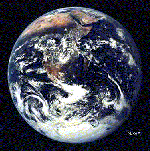|
|
Revising the Pledge of Allegiance a working proposal, email:..vern@cres.org
..........
The division of our nation, so vividly encoded as “red states, blue states,” cries for healing. This hurt is felt by both the right and the left, as well as moderates. Is there a spirit that can restore us?One way we might bridge the divide is to reframe how we look at ourselves, specifically in the Pledge of Allegiance. Its current form perhaps rings too triumphalistic and isolationist for the world where what happens anywhere can affect others around the globe.Your comments are welcome. Email me at..vern@cres.orgFirst, a little theology and a little history. Most people believe that God is universal; in the words of the old hymn, “He has the whole world in his hands.”
But I’ve been troubled by the current pledge which fails to recognize that universality. Instead it is explicit about only “one nation under God.” Isaiah called such a vision “too slight a thing.” Would not most Americans agree that God is Lord of the universe, not just the God of the United States?

The history of the Pledge begins with Baptist minister Francis Bellamy, a Christian socialist, who wrote the original version in 1892. He considered including “equality” in the phrase, “with liberty and justice for all,” but knew that some in the educational system for whom he prepared the Pledge, opposed equality for women and blacks, and so left it out. As the Pledge usage widened, other revisions were made. In 1954, Congress added “under God.”
This history shows the Pledge is a living document, not carved in stone. Perhaps it is time to add back “equality” and to recognize our duty is to all the world and its ecology. So for what it might be worth, here is my current proposal, ready for additional editing and comment.
I pledge allegiance to the Flag of the United States of America,
and to the Republic for which it stands, one nation of many nations,
whose environments on this fragile planet we vow to respect,
as Providence guides us toward liberty, equality and justice for all.
Here is the first attempt, shown on KCPT's Kansas City Week in Review 2004 Nov 26:
I pledge allegiance to the Flag of the United States of America,
and to the Republic for which it stands, one nation of many nations,
whose environments on this fragile planet we vow to protect,
and whose peoples we accept as a sacred trust
moving toward liberty, equality and justice for all.
Let’s omit the word “God” because atheists, agnostics, Buddhists, Taoists, and other non-theists are just as good Americans as Christians, Jews, Muslims, and other theists, as well as polytheists, and deserve to speak the Pledge without feeling their conscience violated.And “God” was not in the original Pledge, which was used for sixty years without it.
But in the spirit of compromise, in this version I’ve included Providence, a capitalized term found in the writings of our nation’s founders, so theists can understand it to mean God and non-theists or polytheists can interpret it poetically as a power moving in history toward the good. To any who insist that Providence should not be used because Providence means too many things, I suggest recalling that God means many different things to different people, even within the Christian faith. And Republican Solicitor General Theodore Olson, in arguing the recent Pledge case before the Supreme Court, has said that “under God” is not even a religious idea!
Vision is a fundamental religious energy. How we envision America is a religious project. Reframing who we are beyond red or blue is the spiritual challenge we face.